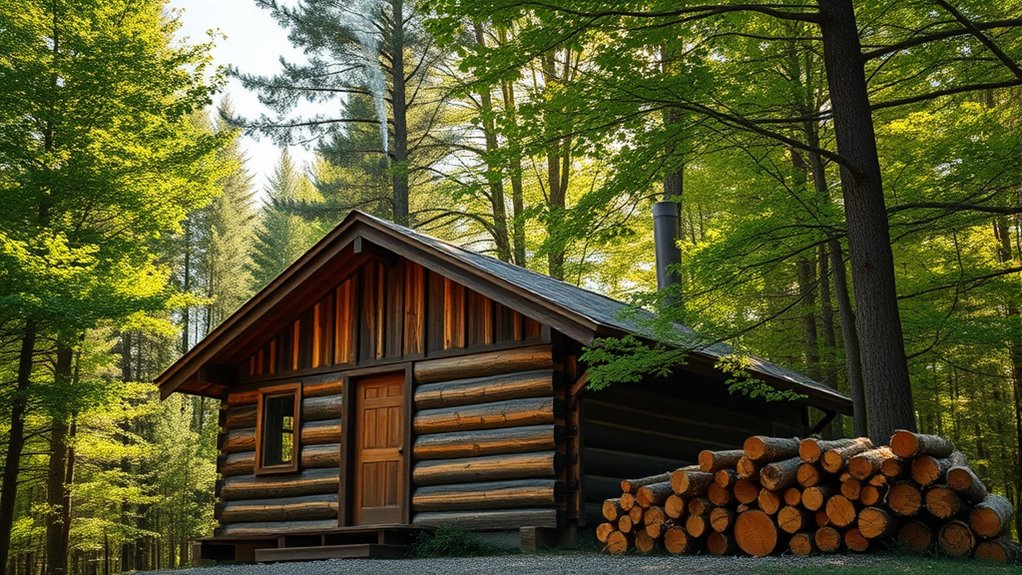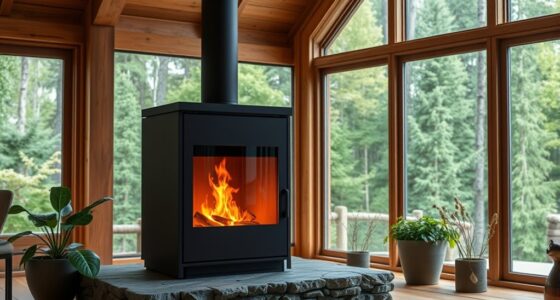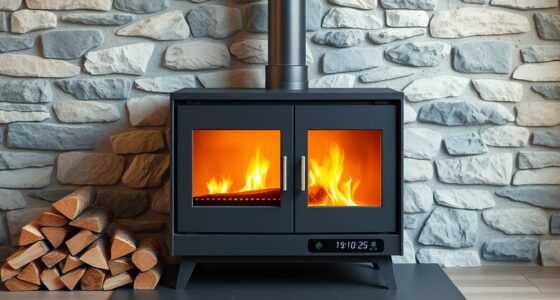Using wood for heating can be carbon neutral if managed sustainably. When you harvest wood responsibly and replant trees, the carbon absorbed during growth offsets the CO₂ released when burning. This cycle keeps atmospheric levels balanced, supporting the idea of biomass energy as renewable. Proper forest management guarantees ongoing carbon sequestration and ecological health. Keep exploring to discover how sustainable practices can help you contribute to a healthier planet.
Key Takeaways
- Burning wood releases carbon, but sustainable harvesting ensures new trees absorb CO₂, maintaining a balanced carbon cycle.
- Replanting and responsible forest management make wood heating a carbon-neutral energy source over time.
- Biomass contributes to carbon sequestration when forests are managed to promote ongoing tree growth.
- Unsustainable practices can lead to increased atmospheric CO₂, disrupting the natural carbon cycle.
- Proper biomass use supports ecological health, biodiversity, and long-term carbon storage in forests.

Have you ever wondered how carbon moves through living plants and the environment? It’s a fascinating process that involves the continuous cycle of carbon exchange between the atmosphere, ecosystems, and living organisms. When you use biomass, like wood for heating, you’re participating in this cycle, which can influence the planet’s overall carbon balance. One key aspect to contemplate is carbon sequestration—the natural process where trees and plants absorb carbon dioxide from the air and store it in their biomass. This process helps reduce the amount of greenhouse gases in the atmosphere, making forests valuable tools in combating climate change. By understanding how biomass contributes to carbon sequestration, you can see that sustainable wood harvesting allows for the ongoing absorption of CO₂, maintaining a relatively stable ecological impact over time.
When you burn wood for heat, you’re releasing carbon that was previously stored in the tree’s biomass back into the atmosphere. However, if the wood comes from well-managed forests, the ecological impact remains minimal because new trees replace those that are harvested, continuing the cycle of carbon absorption. This renewal process is essential; it guarantees that the carbon released during combustion is effectively reabsorbed by new growth, making biomass heating a potentially carbon-neutral activity. This balance is fundamental because it prevents the buildup of excess greenhouse gases, which drive global warming. In this way, biomass can be part of a sustainable energy solution if managed properly, aligning with the goal of reducing our overall carbon footprint.
The ecological impact of biomass energy hinges on responsible practices. When forests are overharvested or not replanted, the ability of the ecosystem to sequester carbon diminishes, leading to a net increase in atmospheric CO₂. Conversely, sustainable forestry practices—planting new trees, protecting existing forests, and ensuring that harvesting levels don’t exceed regrowth—support long-term carbon sequestration. This approach helps preserve biodiversity, soil health, and water resources, demonstrating that biomass energy can be beneficial for the environment. As you think about using wood for heating, it’s important to evaluate the supply chain and guarantee that the biomass source promotes ecological balance rather than harm. When managed correctly, biomass can serve as a renewable and relatively low-impact energy source, contributing positively to efforts against climate change.
In essence, the role of biomass in the carbon cycle hinges on how we manage and utilize it. Properly harvested and replanted forests enhance carbon sequestration and minimize ecological impact, making wood heating a viable option in the transition toward more sustainable energy practices. Understanding this balance helps you appreciate the complex interactions within the biomass carbon cycle and encourages responsible choices that support a healthier planet.
Frequently Asked Questions
How Does Wood Heating Impact Local Air Quality?
Wood heating can negatively impact your local air quality by releasing indoor emissions and particulate pollution. When you burn wood, smoke and fine particles are emitted, which can cause respiratory issues and worsen air pollution in your community. Proper ventilation, using dry, seasoned wood, and installing efficient stoves can reduce these emissions, helping you protect both indoor air quality and your environment.
What Are the Best Practices for Sustainable Biomass Harvesting?
Did you know that sustainable harvesting can increase forest productivity by up to 20%? To guarantee this, you should follow best practices like selective logging, adhering to forest management plans, and avoiding clear-cutting. Proper sustainable harvesting balances biomass extraction with forest regeneration, maintaining ecosystem health. By implementing these strategies, you can help preserve forests’ ecological functions while providing renewable energy sources, making your biomass use both responsible and effective.
Can Biomass Energy Replace All Fossil Fuel Energy Sources?
Biomass energy can’t fully replace all fossil fuel sources yet, but it offers a promising alternative when you focus on biomass efficiency and carbon offset strategies. By improving how efficiently biomass is converted into energy, you can reduce emissions and make it more sustainable. Implementing carbon offset strategies, like replanting trees, helps balance out the carbon released, making biomass a cleaner, renewable option that complements other energy sources.
Are There Advancements in Biomass Carbon Capture Technologies?
Yes, advancements in biomass carbon capture technologies are emerging. You can now find innovations in biomass conversion processes that enhance carbon sequestration, capturing CO2 during biomass processing or combustion. These developments aim to reduce overall emissions and improve sustainability. By integrating carbon capture with biomass energy systems, you help make biomass a more environmentally friendly option, potentially achieving near-carbon neutrality and supporting global efforts to combat climate change.
How Does Seasonal Variation Affect Biomass Carbon Cycles?
Imagine the earth holding its breath during seasonal fluctuations, and you’ll see how they impact biomass carbon cycles. These fluctuations cause variations in carbon storage, as trees grow more in spring and summer, absorbing CO2, and slow down in winter. This natural rhythm influences carbon capture and release, making seasonal changes a crucial factor in understanding how biomass contributes to carbon neutrality throughout the year.
Conclusion
So, next time you cozy up with a wood stove, remember you’re just part of the grand carbon recycling show. Sure, burning wood seems green, but in this drama, you’re really just pretending to be an eco-hero while emitting a little carbon to keep the planet spinning. Who knew that cozy fire might be the planet’s sneakiest actor in the climate crisis? Enjoy your warm glow — just don’t forget to thank the carbon cycle’s behind-the-scenes magic.










